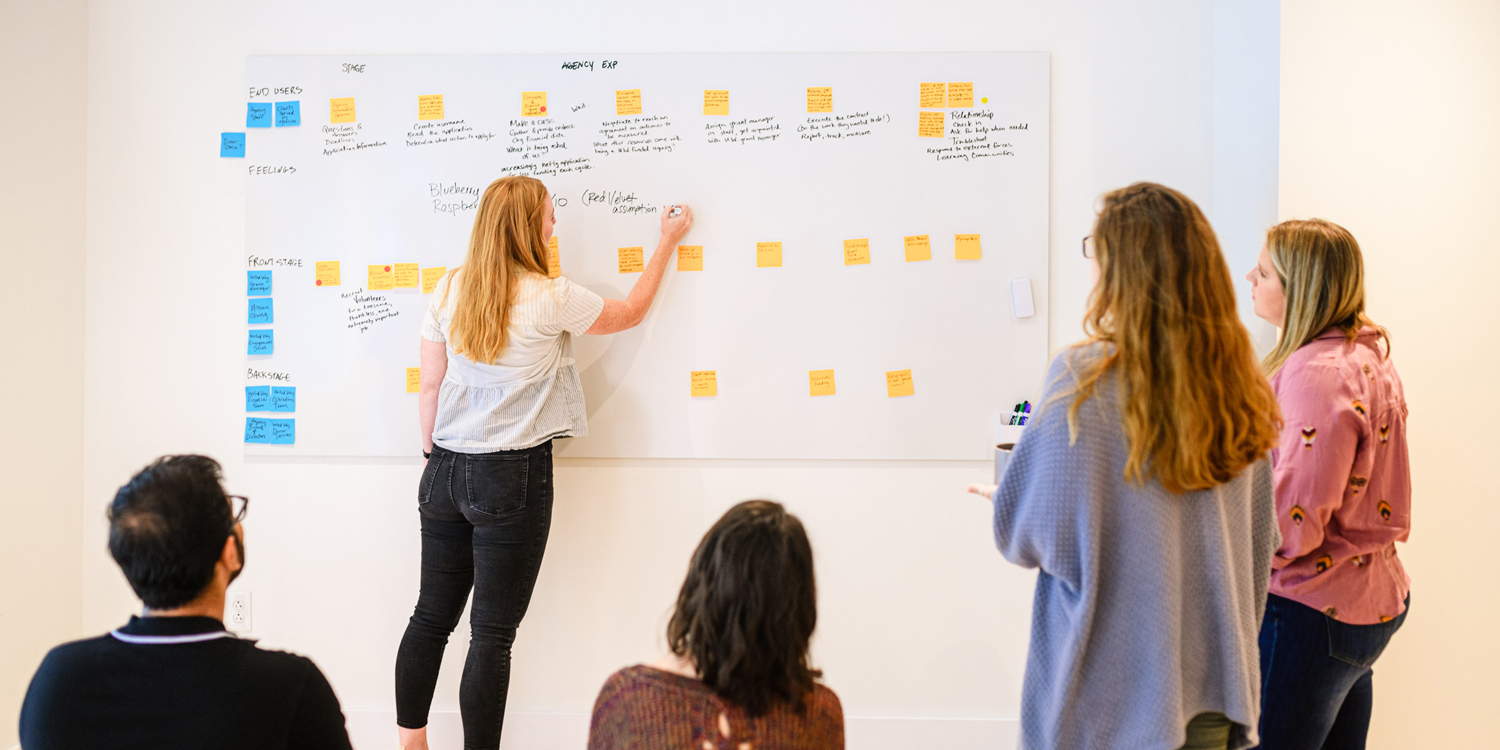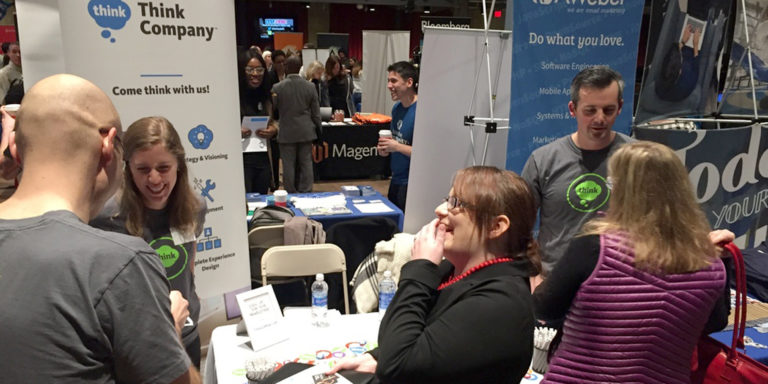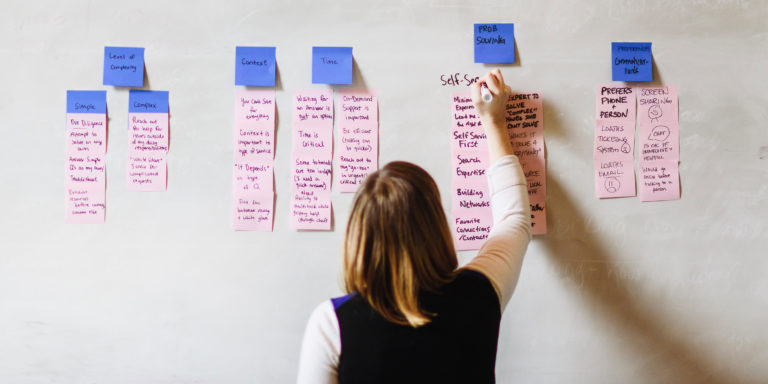90+ UI/UX career path tips & resources

Through our recruiting efforts and general involvement in the design community, we have the opportunity to connect with many folks looking to transition into the UX or technology fields. It’s always an exciting reminder that this industry is one that people are eager to learn about and break into. Over the years, we’ve started to compile a list of helpful UX and UI resources to share with anyone looking to learn, grow, or make a career transition.
This list has been a collaborative effort across multiple members of our design team, including hiring managers and experienced practitioners, and we’re actively maintaining and growing it. Currently, we’re seeking out a more diverse set of voices and resources to include in order to better represent the future of UX that we hope to see.
In this post, we’ll cover:
- UX design and technology books
- UX articles and resources
- UX design and technology professionals you should follow
- Philadelphia-based UX design and technology organizations
- National and global UX design and technology organizations
- UX design and technology programs
- UX career resources by Think Company
- Common UX/UI design tools
- What we look for in UI/UX design candidates
UX design and technology books
Reading UX design books is a great way to gain education about the field and the emerging areas of UX design. Below are the books we’d recommend you put on your reading list to learn from the experts and increase your knowledge.
- 100 Things Every Designer Needs to Know About People by Susan Weinschenk. This book helps you apply basic techniques or logic from psychology and behavioral science to your design process.
- Design is a Job by Mike Monteiro. Designers aren’t special. We’re humans working a job like everyone else. Design being a job means there are parts we like and parts we’d rather avoid. This book talks about the parts that aren’t so glamorous, but are essential to career success.
- Don’t Make Me Think by Steve Krug. One of the best-loved and most recommended books on usability.
- Expressive Design Systems by Yesenia Perez-Cruz. This book shows you how to build useful, dependable systems that not only maintain harmony across your products, but also flex to accommodate inspiration and experimentation.
- How to Make Sense of Any Mess by Abby Covert. This is a book about information architecture, for anybody.
- Practical Empathy by Indi Young. This book helps you shift into an empathetic space. Empathy is a mindset that focuses on people, helping you to understand their thinking patterns and perspectives.
- Technology As Experience by McCarthy and Wright. An academic, research-supported take on how to think and talk about human experience.
- The Design of Design: Essays from a Computer Scientist by Frederick P. Brooks Jr. The second half of the book gets a bit heavy into the computer science part of things, but the rest is a great treatise on what makes design…design.
- The Design of Everyday Things by Don Norman. Some say this is one of the books that started UX. It’s not technically about interface design, but it’s an important read.
- The Design Way by Erik Stolterman and Harold Nelson. A reflection on design as a human activity. This covers the gamut: design thinking, ethics, and heuristics to support design practice.
- The Inmates are Running the Asylum by Alan Cooper. This book takes a little bit of a hard line against software engineering, but establishes another baseline for UX as a profession.
- User Experience Team of One by Leah Buley. This book prescribes a range of approaches that have big impact and take less time and fewer resources than the standard lineup of UX deliverables.
- Inclusive Design for a Digital World by Regine M. Gilbert. This book is a great resource on inclusive design and how to build a product with the intention of making it as accessible to as many users as possible.
UX articles and resources
Many of our favorite UX resources exist in the form of articles, podcasts, and publishing organizations that continue to provide value in our field year after year. Put these on your reading, listening, and following list.
- 134: Chief Jobs Officer (The Critical Path) – if you want to explore a specific research technique related to “Jobs to be Done” thinking, this podcast episode provides a great overview
- A Book Apart is a publishing group that focuses on design, content, and technology. Their collection often changes. Their content is always solid.
- ADPList – a platform that helps people find, book, and meet mentors around the world
- Atomic Classification – we’ve done deep thinking about how to create extensible design languages that can grow and flex over time. This short article sums up the atomic design approach well
- Device-Agnostic – we also need to consider how our work is going to be experienced in an unfathomable number of circumstances, hence the need for responsive design
- Enterprise Software Design: A Call to Arms – this article references how we approach what is often referred to as “complex system design”
- Get Interviewed – a podcast by Thinker Joe Pascavage, who interviews individuals in the creative industry to level up their voices and share their stories
- Just Enough Research – we do a lot of research, some of it formal, some more casual. Regardless, we want to define the problem and get outside of our heads. This video on “Just Enough Research” describes the value and purpose of asking “why?” and how to create a research plan that’s proportionate to your needs
- Laws of UX – a survey and explanation of some of the principles that interface designers tend to follow
- Nielsen Norman Group – UX training, events, and research reports.
- Rosenfeld is a media company creating UX books, training materials, and conferences to help you think and design better. They release timely and relevant content on a variety of industry topics.
- Think Company’s YouTube Channel – we started recording and sharing webinars, interviews, and insights on the industry in 2020 and plan to continue doing that into the future
- What Screens Want – digital design is a distinct medium that requires a unique way of thinking and applying universal design principles. Here’s some thoughts on approaching digital design
UX design and technology professionals you should follow
Our favorite professionals in the field share or produce great UX resources regularly. Follow these people and organizations for long-term education and connection.
- Annie Jean-Baptiste, Head of Product Inclusion at Google and Author of Building for Everyone
- Ashley Turner, founder of Philly Tech Sistas and recent guest on Getting Past the “What Do We Do Now?” Conversation in Black and Brown Tech
- Brad Frost, Design System expert and author of Atomic Design
- Brenda Matos, Product Design Lead, REEF
- Dan Mall, design systems expert and founder of SuperFriendly
- David Dylan Thomas, host of The Cognitive Bias Podcast and author of Design for Cognitive Bias
- Debbie Millman, designer, writer, speaker, and host of Design Matters podcast
- Erick Gavin, Senior Program Manager, Center for Black Innovation
- Irene Au, Design Partner at Khosla Ventures; former head of design at Google, Yahoo, Udacity.
- Jacquelyn Iyameh, Founder of the Black UX Collective
- Maedastudio, the work of designer, educator, and author John Maeda
- Julie Zhuo, expert on building products, teams, and self. Former VP of Design at Facebook.
- Karen McGrane, UX and content strategy specialist
- Kristina Halvorson, content Strategy specialist, speaker, and writer. Founder: @BrainTraffic, @ConfabEvents, @ButtonConf.
- Luke Wroblewski, author of Mobile First.
- Mariam Braimah, Product Designer at Netflix, Founder of Kimoyo Fellowship
- Maurice Cherry, creative strategist, designer, and digital creator
- Michael O’Bryan, founder of Humanature and recent guest on Putting Humanity at the Center of Design
- Mitzi Okou, Interaction and Visual Designer, organizer of “Where are the Black Designers?” virtual conference
- Nancy Douyon, global design ethicist & product philosopher
- Natalie Nixon, creativity strategist, keynote speaker, and President, Figure 8 Thinking
- Patrick Neeman, usability specialist
- Peter Merholz, founder of Adaptive Path, creator of the design blog peterme.com.
- Tori Hinn, creator of Women of Graphic Design, and Creative Director at Figma
- Wil Reynolds, VP Innovation at Seer Interactive
- Yesenia Perez-Cruz, design system expert and author of Expressive Design Systems
Philadelphia-based UX design and technology organizations
The global pandemic has shifted how we meet and collaborate. While Think Company is a company based in Philadelphia, much of our networking was local prior to 2020. While many of these organizations are local to Philly, they still produce great content, regardless of where you live.
- Creative Mornings Philadelphia
- Design Brew Philadelphia
- Hopeworks
- PANMA Philadelphia
- Philly CHI
- Philly Content Strategy Meetup
- Philly Tech Sistas
- OnE Philadelphia
- Research Rewind
National and global UX design and technology organizations
National organizations provide excellent resources, events, and opportunities to connect on a broader level. Many Thinkers have enjoyed learning from these organizations over the years.
- Black UX Collective
- Blacks Who Design
- Hexagon
- Interaction Design Association
- Latinx Design Directory
- TCTLE
- Where are the Black Designers?
- Women Who Design
UX design and technology programs
For many IU/UX design beginners, educational programs provide a great foundational knowledge of the field and help students find local and national connections for practical work at hiring organizations.
Universities and colleges
For many UI/UX design beginners, educational programs provide a great foundational knowledge of the field and help students find local and national connections for practical work at hiring organizations.
- In Philadelphia: Temple University, Drexel University, and Jefferson University all have Digital Design / UX programs you can look into
- Outside of Philadelphia: Many universities across the world offer UX and Design coursework under several different models. For example, the Stanford D. School allows students to get design certifications attached to their traditional degrees.
- To find a program that works for you – look through a school’s curriculum for UX and Design courses that focus on human-centered design. These programs may be part of a larger program in:
- Fine Art / Graphic Design
- Arts and Sciences / Liberal Arts
- Computer Science / Information Systems
- Industrial Design / Architecture
UX design certificate programs
Many people attend bootcamps or UX certification programs to pick up skills, work with tools, and gain practical knowledge about the industry. A few we are aware of include:
UX career resources by Think Company
We write a lot about the topic of careers in UX and Technology. All of our Career-based articles are tagged at our career wisdom link. But for a few of our highlights:
- Thoughts from the Other Side of the Job Fair Table
- Advice for Seeking a Career in UX
- Advice for Liberal Arts Majors: Consider a Career in UX
- 7 Habits of Highly Effective Digital Project Managers
Common UX/UI design tools
Before you dig deep into tools, it’s important to note that the tools used by designers change often. You should maintain the perspective that tools can and will change, but your ability to stay organized within a tool, and to collaborate with others, is the real skill you should master. However, you will be expected to have some level of proficiency in one or many of these tools:
- Abstract – a tool for collaborating, sharing, and managing design assets
- Adobe Xd – Adobe’s interface design, prototyping, and collaboration platform
- Figma – an interface design, prototyping, and collaboration platform
- Invision – a prototyping tool
- Miro – a collaboration and whiteboard tool
- Mural – a collaboration and whiteboard tool
- Sketch – an interface design tool
What we look for in UI/UX design candidates
There is so much talent out there, it’s hard for a candidate to float to the top. Here are some things you can do to help us at Think Company understand your capabilities as a UX or UI designer.
Pick up at least a little project experience. We like to hire people with at least a little bit of experience working with clients and on teams in a project setting. There are many ways to pick that up. If you haven’t had that yet, there are many things you can do:
- Take a capstone class in school
- Sign up for an internship
- Attend some of the meetups above to find a volunteer project
- Start your own company
- Enroll in a certification program
Many folks get entry-level positions at one of the larger corporations in the area, then bounce over to us once they’ve built up a portfolio. Speaking of which…
Compile a portfolio of your work. Regardless of whether you’re looking for a position as a visual designer, experience designer, researcher, or developer, your portfolio shows what you can do. This can be as simple as a collection of images, a case study for one of your projects, or code samples on GitHub. You don’t need to know how to code; many portfolios are created on web design platforms such as Squarespace or Wix. If everything you have is proprietary, tell us that and offer to walk through a deck that you cannot leave behind. We’ll understand.
Submit a cover letter with your resume. Yes, we read cover letters. It shows us how you communicate. If you think the job you’re applying for doesn’t need communication skills, this is probably not the place for you. If you don’t submit a cover letter, your likelihood of being considered drops dramatically.
Get to know us. Follow our social media channels (Twitter, Facebook, Instagram, and LinkedIn), attend virtual events or physical events in our space (we announce these events on social media), attend events around the region and community, and introduce yourself to us when you see us out and about. The design community—especially in Philadelphia—is small. We’re all great people and like to get to know folks from all walks of life.
Finally, if you would like to be considered for a position, keep an eye on dev-think-company.pantheonsite.io/careers and send us your info.
Breaking into the UX design field is a journey
Whether you want to break into UX or any other industry, it’s not usually an instantaneous process—and it often looks more like a meandering journey than a straight line. In UX, the key components to keep in mind when considering how to start a career in UX are to stay educated about the fundamental concepts and emerging ideas, connect with others in the field, and keep your eyes open for opportunities to gain experience.
We hope this list is helpful to you as you embark on your own journey into UX. Stay in touch with us!
Want to learn more about the latest in design and technology leadership? Sign up for the Think Company newsletter.



